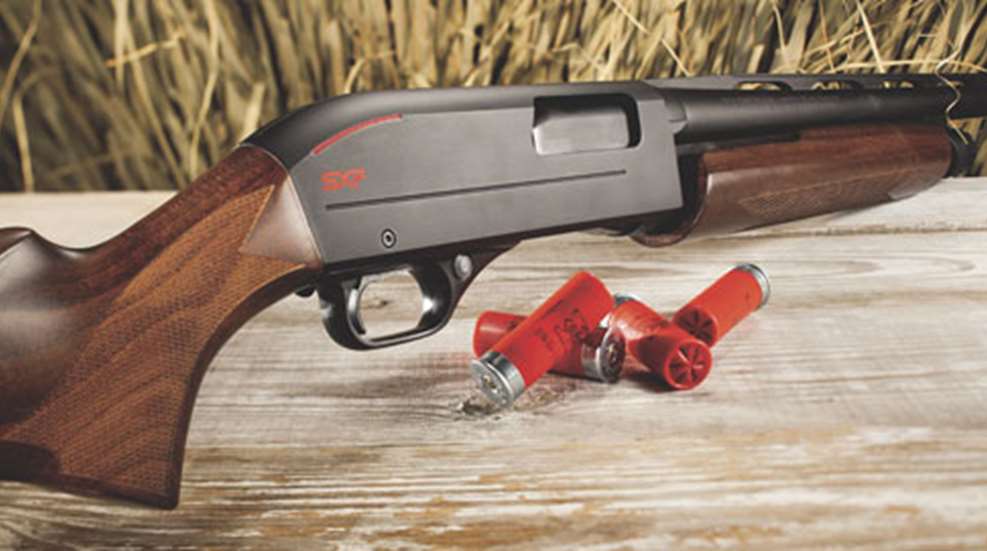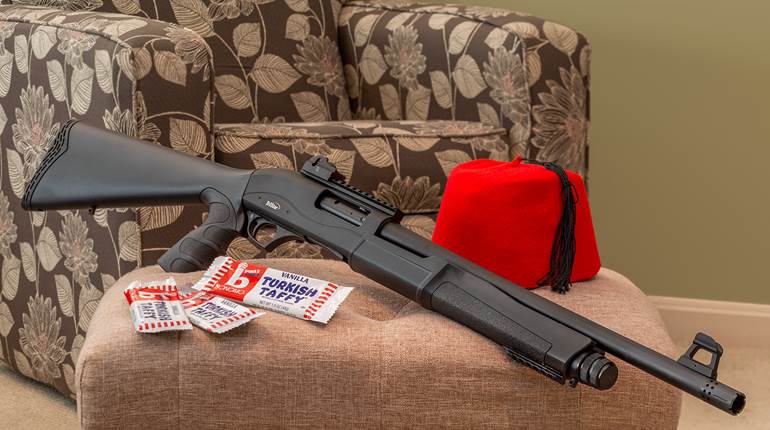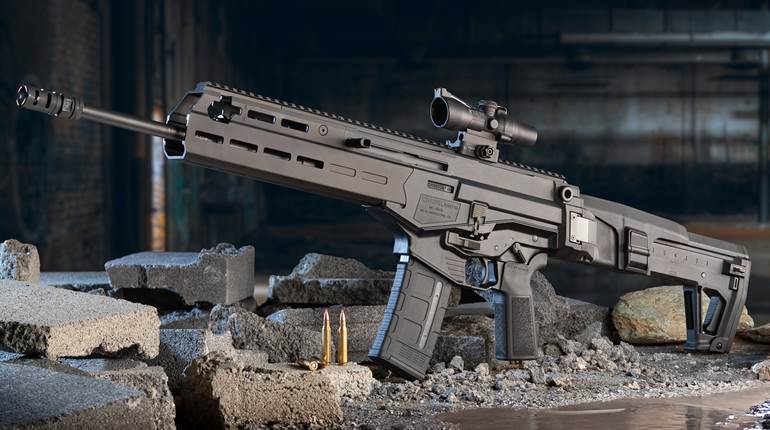
5/23/2013
The pump-action shotgun is purely American. It began with Christopher Spencer’s toggle-action, followed shortly by the John Browning-designed Winchester Model 1893. At that time, hunters and shooters were on the cusp of “white” or smokeless propellant displacing blackpowder, and the 1893’s open-top action was not up to the higher pressures, so it was replaced by Browning’s stronger Model 1897 that was produced for more than half a century. Keeping the tradition, Winchester recently came out with the SXP, short for Super X Pump, which leads them into the 21st century.
Made in Turkey for Winchester, the company touts it as “The world’s fastest pump-action,” and its claim isn’t far off the mark. In testing we found the cycling amazingly fast, perhaps due to what Winchester calls its “inertia-assisted action.” Strange, because if you try to cycle it slowly, it seems stiff and unyielding, but in the field it is fast and smooth. In testing, the slide came back unassisted and in most cases fast enough to eject the fired shell. The hand on the slide may actually be an impediment to fast operation, except that it is needed to complete the cycle of carrying the next round into the chamber. To aid smooth cycling, the SXP has dual action bars that prevent twisting and binding.
Our test gun was the “Field” model that has satin-finished hardwood with attractive checkering; considerably nicer than one would expect on a shotgun of this price. Capping the stock is Winchester’s Inflex Technology recoil pad that is designed to direct the recoil down and away from the shooter’s cheek. In testing with Hornady’s 1½-ounce, 3-inch turkey loads, the recoil was stiff, but the SXP was surprisingly pleasant to shoot; even more so on the skeet range with Federal’s Gold Medal Extra-Lite target loads.
The action is machined from high-strength aluminum and finished in an attractive matte black. All the stresses of firing are taken up by the bolt’s locking lugs with little or no strain on the receiver. The SXP uses four large lugs located on the rotating bolt’s head that engage matching recesses in the breech end of the barrel. The lugs rotate into position by means of a cam located within the bolt’s body. Such lugs are fast to lock up, easy to unlock, and provide superior strength over older designs that use rising locking blocks within the bolt’s body. In addition, the bolt and other moving parts are hard black chrome-plated for less friction and smoother function.
The trigger group is easily removed for cleaning and inspection by drifting out a single pin. A quick cleaning with a dirt-flushing aerosol and light lubrication is all that’s needed to keep the SXP running. The trigger pull averaged a hefty 10 pounds when measured on a Lyman digital scale; very heavy, but on a repeater not all that cumbersome. The safety is a familiar crossbolt-style located in the front of the trigger guard. Winchester officials say it’s in easy reach, but if one has short fingers, it can be a bit of a stretch.
The barrel’s bore and chamber are hard-chrome-plated for smooth extraction and because chrome plating is impervious to rust and corrosion. Our test gun was chambered for 2¾- and 3-inch shells. The waterfowl and turkey models are chambered for 3½-inch 12 gauge. The SXP uses Winchester/Browning’s familiar Invector-Plus choke tubes, enabling the user to quickly adapt to whatever shooting situation he encounters. The SXP comes with three Invector-Plus tubes; improved cylinder, modified and full. In checking with a barrel micrometer, the cylinder bore measured 0.740 inches six inches behind the muzzle. Winchester advertises 0.742 inches, but 0.740 inches is well within manufacturing tolerances. The constriction of the IC tube measured 0.0055 inches, modified 0.013 inches and full 0.033 inches. The IC and modified tubes were more open, the standard for them being IC 0.010 inches and modified 0.020 inches, but OEM tubes delivered with any shotgun can vary considerably, and the only way to ascertain how they perform is on the patterning range.
We shot Hornady Heavy Magnum Turkey loads with 1½ ounces of No. 5 shot using the supplied full choke tube, as is standard for most turkey hunters. The 10-pattern average for this particular load/choke combination in this barrel was 71 percent at 40 yards—spot on for full-choke performance. Hornady states the velocity to be 1,300 fps, and the 10-shot average was 1,301 fps with the slowest 3-foot velocity being 1,214 fps and the highest 1,350 fps.
Other features of the SXP are Winchester’s Speed-Plug system that allows quick placing or removal of the factory-installed magazine plug. One need only unscrew the magazine cap and then push down on the spring retainer to remove it and the plug will slide out. We were unsure of the advantage this feature provides, but one needs to be careful that the magazine spring does not rocket out of the magazine tube and into the water or brush, essentially turning a slick repeater into a single shot.
The stock dimensions are pretty common among American repeaters, and one notices the absence of a shim kit, already available on other Winchester repeaters. The gun shot well in our tests using skeet targets. One thing we noticed was that on our test for impact on low seven skeet, the gun with the full choke in place shot fairly high, about a foot at 20 yards, and we had to hold well under the targets to consistently break them. We also had to hold low at the patterning board to register the shot fully on target. Not all bad, as this allows the shooter to see the bird above the barrel rather than being obscured by the gun.
Throughout our test, we found the SXP to be quite a nice shotgun, especially for the money. One could spend more and do a lot worse.
Importer: Winchester Repeating Arms; (800) 945-5237; winchesterguns.com
Action type: pump-action shotgun
Gauge: 12 ga., 3" (test gun) 3½" chambering available in the waterfowl and turkey models.
Trigger: single-stage; 10-lb. pull
Magazine: tubular; four- (2¾") or three-round (3") capacity
Barrel: 28" (test gun) with ventilated rib, backbored to 0.740" (test gun), chamber and bore chrome plated and exterior matte blued
Sights: single brass bead at muzzle
Stock: pistol grip-style stock of walnut-colored hardwood with satin finish; length of pull, 141⁄16"; drop at comb, 15/8"; drop at heel, 2¼"
Overall Length: 48¾"
Weight: 7 lbs. 6 ozs.
Metal Finish: matte black; receiver anodized matte black, barrel matte blued, internal parts black chrome.
Accessories: owner’s manual, three choke tubes, choke-tube wrench
Suggested Retail Price: $400





































